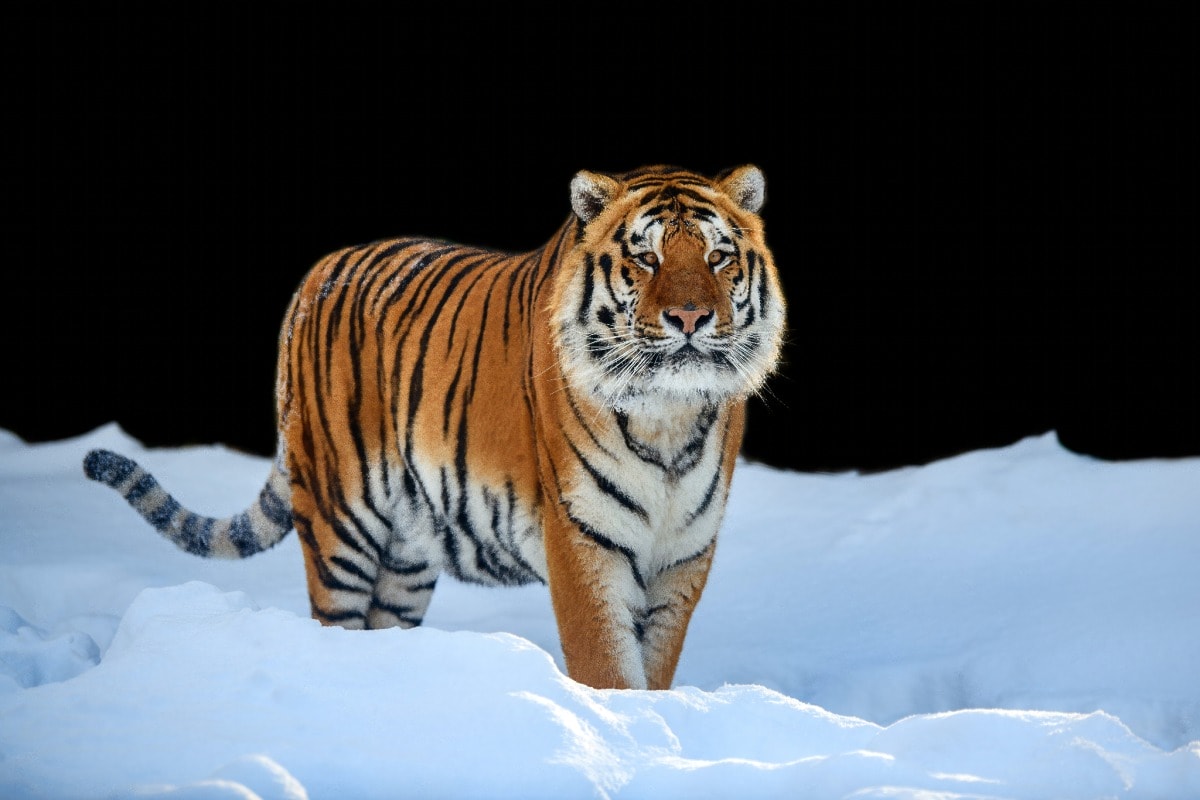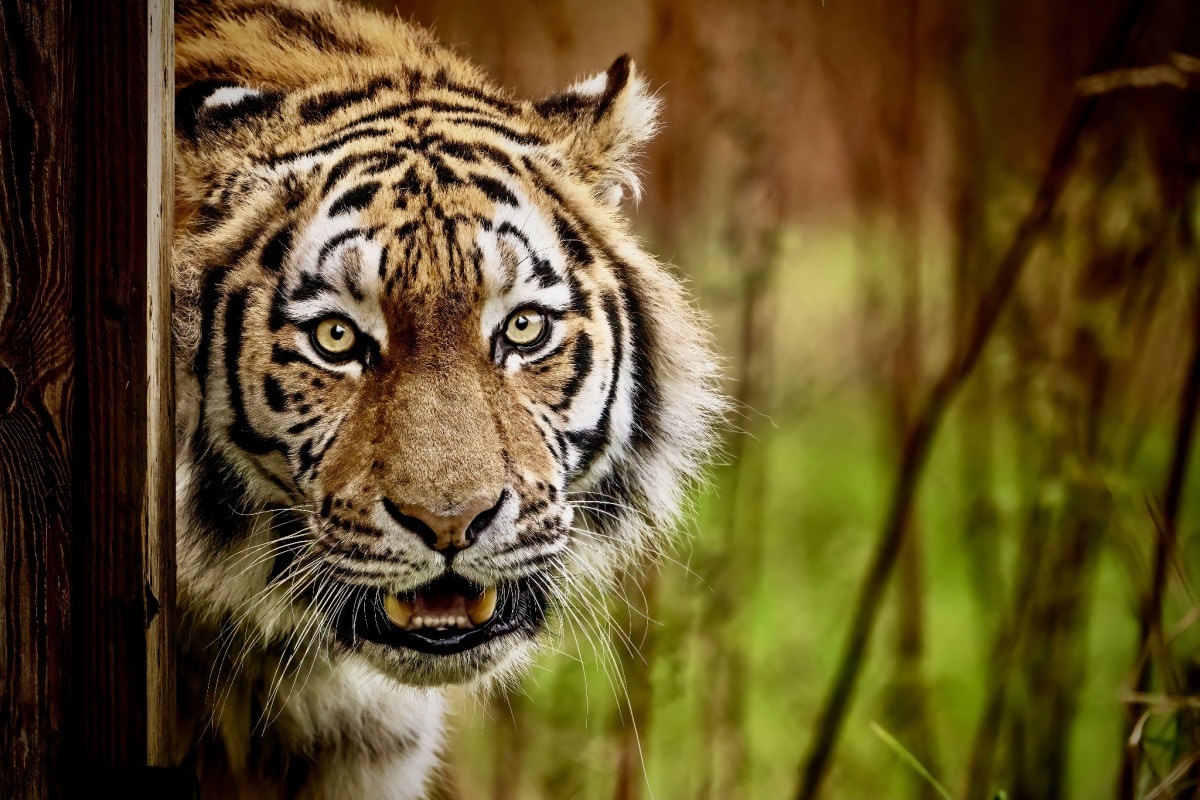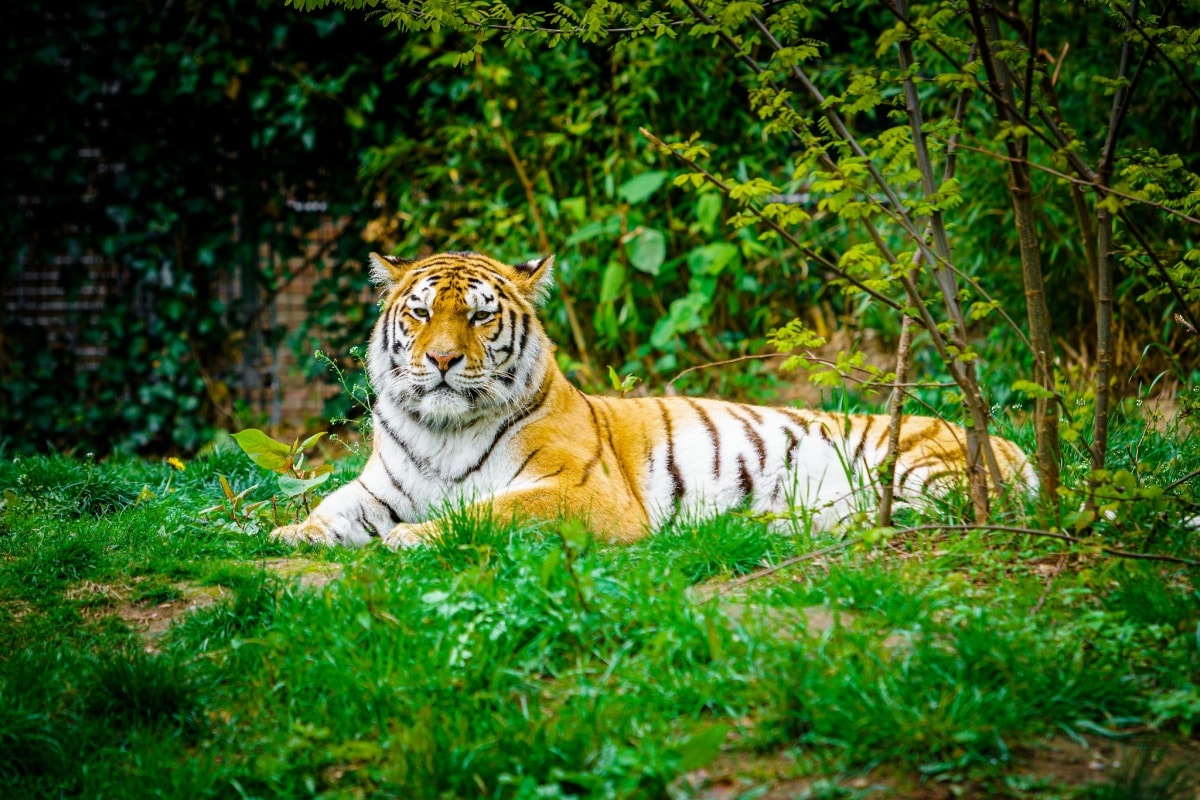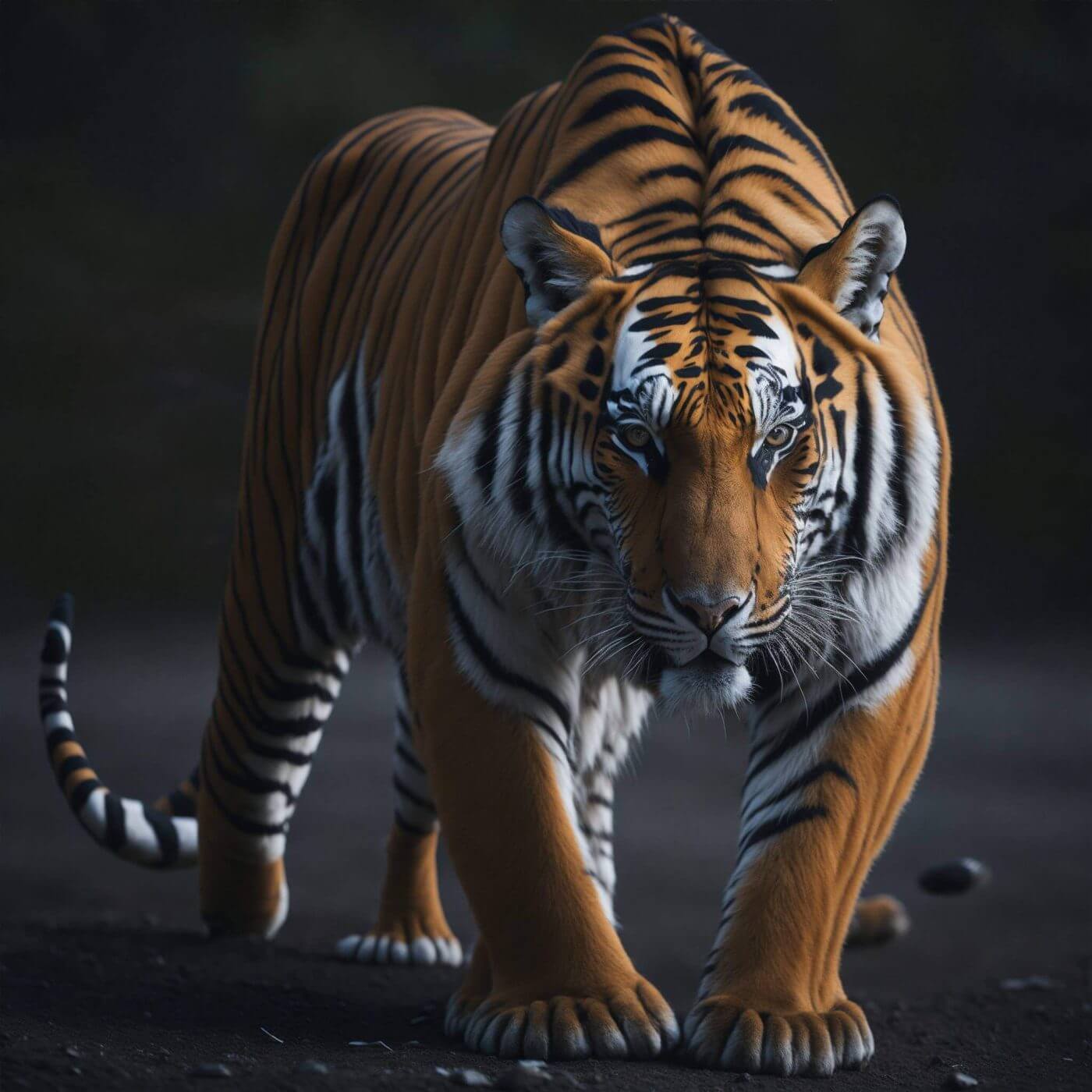The Siberian tiger, also called the Amur tiger, is a beautiful and powerful animal in danger of disappearing forever. It’s the biggest type of tiger, but it’s facing many problems that could mean we won’t have any left in the wild. People are working hard to protect these tigers through conservation efforts, ensuring they have safe places to live and are safe from harm. This work gives us hope that we can save these incredible animals.
It’s important to understand what the Siberian tiger needs to live safely, like a home without being destroyed and enough food. When we know about these needs and the problems tigers are facing, we can all help out. Helping save the Siberian tiger is about more than just doing something good; it’s about caring for our planet. This story wants to show you how even the smallest help from us can make a big difference for these tigers and our world.

Key Takeaways
- The Siberian tiger is the largest of the tiger species, yet it is classified as endangered.
- Factors such as habitat loss and poaching significantly threaten their existence.
- Understanding Siberian tigers’ natural behaviour and needs is key to their conservation.
- Individuals can make a difference through the support of wildlife preservation initiatives.
- Knowledge and education about Siberian tiger conservation are vital to the species’ future.
Uncovering the Mystique of the Siberian Tiger
Entering the world of the Siberian tiger is like stepping into a place where sheer strength and quiet mystery come together. These tigers, also known as Amur tigers, are the epitome of wild beauty and power. They earn the admiration of all who learn about them, embodying the spirit of the wilderness and offering a peek into the grandeur of nature.
Majestic Felines: Understanding the Largest Tiger Species
The Siberian tiger claims the title of the largest tiger species, tracing its roots back to ancient forests. The Siberian tiger stands out with its:
- Large size, with males stretching up to 3.3 meters long.
- Heavyweights, with males weighing as much as 300 kilograms.
- Beautiful orange coats with bold, black stripes.
Their thick fur insides against intense cold, and large paws work like snowshoes, showcasing their adaptability. New Siberian tiger facts constantly emerge, deepening our appreciation for these incredible animals.
Siberian Tiger Characteristics and Unusual Behaviors
What makes the Siberian tiger fascinating are its behaviours:
- They prefer living alone, quietly marking and patrolling their large territories.
- They use sounds like roars and chuffs to talk to each other across the vast wilderness.
- As nighttime hunters, their skill lies in stalking their prey silently before a swift capture.
Thriving in some of the coldest places on Earth, they tailor their behaviours to survive and flourish in extreme conditions. Every rare glimpse or finding about their lifestyle adds to our understanding and awe of them.
Reflecting on the Siberian tiger, we’re drawn to learn more and discover the secrets of their existence. We aim to preserve these magnificent creatures through ongoing research and conservation so future generations can also marvel at them.
The Declining Numbers: Siberian Tiger Population Concerns
Wildlife lovers worldwide are worried about the Siberian tiger. This big and powerful animal used to roam freely in Eastern Russia, China, and the Korean Peninsula. These tigers are facing tough times and are very close to becoming extinct.
Looking at the numbers, we see that only a few hundred of these tigers are left in the wild. The reasons for their decreasing numbers include losing their homes because of human activities, illegal hunting, changes in the environment, and fights with people living nearby.
However, there’s still hope, thanks to strong efforts to save the Siberian tiger. Teams are working hard to stop poaching, make laws to protect wildlife stronger, and create safe places for tigers to live. But saving these tigers is not easy.
Keeping the tigers genetically diverse is important, too. A wide variety of genes means tigers can fight off diseases better and adapt to environmental changes. Therefore, conservation programs are actively working on the following:
- Breeding programs to keep the tigers’ gene pool healthy
- There are better ways to monitor how many tigers there are and how healthy they are.
- Working together with experts from different countries to share the best ways to protect tigers
- Getting local communities involved to help people and tigers live together peacefully
These steps are crucial for ensuring the Siberian tiger has a chance at a better future. Through teamwork, smart planning, and dedication, there’s hope for these magnificent animals to thrive once again.
Exploring the Realm of the Siberian Tiger
The Siberian tiger lives in a world as wild and tough as the tiger. Imagine vast landscapes in Siberia filled with thick forests and steep hills, creating the perfect backdrop for these big cats. This is where the tiger’s adventurous spirit meets nature’s stunning beauty. Let’s journey into the heart of this wild land to see where the Siberian tiger calls home.
Adapting to Harsh Conditions: The Natural Habitat of the Siberian Tiger
The home of the Siberian tiger covers parts of North-Eastern China, Eastern Russia, and maybe even North Korea. It’s a mix of forests with tall, needle-leaved and broad-leaved trees, crossed by rivers and often covered with snow. Despite the cold winters and mild summers, the Siberian tiger has learned to thrive here.
These tigers handle cold and limited food with thick fur, a strong body, and smart hunting skills to catch animals like deer and wild boar. The quiet of the Siberian forests holds many secrets about the tiger’s life, showing how connected they are to their chilly world.
Rare Sightings: Where to Find the Wild Siberian Tiger
Seeing a Siberian tiger in the wild is rare but unforgettable. They live in places that are hard to get to but full of the resources they need to live, hunt, and raise their families. Keeping these areas safe is key to the tigers’ survival and shows how saving their home helps the whole ecosystem.
Some of the best places to possibly see a Siberian tiger in the wild include:
- Primorski Krai in Russia, with its wild mountains and deep forests.
- The Greater Hinggan Range is full of trees and animals the tigers can eat.
- The Sikhote-Alin Biosphere Reserve is a protected area that shows off the rich variety of life in these forests.
Thanks to hard work in conservation, the areas where Siberian tigers live are a reminder of how tough and enduring Siberian wildlife can be. In these untouched parts of nature, we see the lasting mark of the Siberian tiger and the wild heart of Siberia.
Survival on the Edge: Siberian Tiger Diet and Predation
Endangered species like the Siberian tiger play a big role in their homes as top hunters. The way they hunt and what they eat help keep nature in balance. These tigers need a variety of animals from the huge Siberian lands to stay healthy.

Siberian tigers mostly eat big, hoofed animals. But finding enough food can be tricky because the weather and land are always changing. These changes affect how many animals there are for tigers to eat. Still, Siberian tigers are great at adjusting their hunting to catch whatever food is around.
- Red deer and wild boar are their favourites because they’re big and full of the protein tigers need.
- Roe deer are quicker and smaller, so tigers must be sneaky to catch them.
- When there’s not much food, tigers can also eat fish or small animals, showing they can eat different things when needed.
Learning about how Siberian tigers hunt and what affects their meals is important for keeping them safe. By understanding what tigers eat and how they find their food, people working to protect them can also help the forest stay healthy. Saving these big cats means caring for the whole area where they live.
Threats Pushing the Siberian Tiger Closer to Extinction
The Siberian tiger, one of the most magnificent wild animals, faces huge dangers because of illegal hunting, losing their living spaces, and the trade of animals and their parts against the law. People who want to make money without caring about the harm they do cause these problems, putting these great tigers in danger of disappearing forever. This situation is bad not just for the tigers but also for all kinds of life on Earth.
The Dark World of Poaching and Illegal Wildlife Trade
Illegal hunting is a big threat to the Siberian tiger. Even though there are strict rules against it, the high prices tiger parts can get on the black market keep poachers coming. These parts are used in some traditional medicines, as decorations, or as symbols of wealth, all of which increase hunting and seriously hurt efforts to protect these tigers.
Habitat Loss: Understanding the Consequences of Human Expansion
Losing their homes is another serious problem for Siberian tigers. As people take over more land for farming, logging, or building, tigers have less and less wild space. This makes it hard for tigers to find places to live and leaves them with fewer animals to hunt, making it even harder for them to survive.
- Logging for timber
- Turning wild places into farms
- Building projects that break up their living spaces
- There are fewer animals for the tigers to hunt because of too much hunting.
It’s really important to tackle these issues to help the Siberian tiger population grow again and to stop them from moving closer to extinction.
Efforts to Conserve and Preserve the Siberian Tiger
The Siberian tiger conservation effort is a big, important project that needs everyone worldwide’s help. This includes groups outside the government, governments, and local people. Everyone’s work is different, but all of it together helps save wildlife.
There are now strong laws against hunting tigers illegally and agreements between countries to protect animals. These rules are crucial in preventing people from harming tigers and ensuring that those who do so can be apprehended.
Sanctuaries are special places where Siberian tigers can live safely, almost like in the wild. These places are safe for grown-up tigers and their babies, helping more tigers grow up healthy.
Working together, people who know a lot about saving animals and people who live near the tigers use old and new ways to protect them. Scientists study the tigers to develop the best plans to keep them safe, and educational programs teach people why it’s important to care about wildlife conservation. This helps more people want to help save the tigers.
All these different ways of helping are starting to work. There are a few more Siberian tigers now, although there still aren’t enough. But it gives us hope that these beautiful tigers will live in Siberia’s forests for a long time.
The Role of Science in Siberian Tiger Conservation
Tiger conservation research is like a map that guides those working to save wildlife, especially Siberian tigers. By closely following the tigers, studying them deeply, and using smart science, we can hope to keep them around for a long time. Science plays a big role in determining the best ways to protect these animals.
Tracking and Research: Essential Tools for Understanding Siberian Tigers
Following Siberian tigers in their natural, wild homes is a big challenge for scientists. When tigers walk in the snow, they leave clues behind that scientists use to learn more about them. This information helps us understand where tigers go, how they live, their health, and how many there are.
Conservation Genetics: A Ray of Hope for the Endangered Species
Using conservation genetics is a new and exciting way to help save the tigers. This science lets experts look at the tigers’ genes to understand how different all the tigers are from each other, which helps keep the tiger families healthy. It also helps stop problems when tigers are too closely related.
- Putting GPS collars on tigers to see where they go
- Testing tiger droppings to check on the health of the tiger group
- Helping sick or injured tigers get better, using what we learn from watching how they behave
Bringing together technology and science to help Siberian tigers shows how we can use human smarts and creativity to meet the needs of the natural world. Science doesn’t just help with saving the tigers—it gives us hope and the determination to keep going.
Siberian Tiger Adaptations: Evolution’s Response to Extremes
The Siberian tiger adaptations are amazing examples of how animals can change to survive in their environments. These big, beautiful tigers have special features that let them live in the cold world of Siberia. Here’s how they’ve become experts at living in such a cold place:

- They have thick fur and a layer of fat that keeps them warm in freezing weather.
- Their big paws work like snowshoes, helping them walk on deep snow without sinking.
- Their fur has a pattern that makes them blend in with the snowy and forested surroundings, making it perfect for hiding.
Behavioural Adaptations:
- They change what they eat based on the season, which helps them stay strong and healthy all year.
- They roam over large areas to find enough food and meet other tigers.
- They hunt at night, using the darkness to sneak up on their prey.
As our world changes, with places where wild animals live getting smaller or changing because of the weather and human activities, the Siberian tiger’s ability to adapt is incredibly important. These adaptations are like secret weapons that help them survive in tough conditions.
How the Global Community Can Aid in Tiger Conservation
Saving Siberian tigers isn’t just one country’s job; it needs people worldwide working together. Combining the knowledge and resources from different places can create a safe space for these incredible animals. When we all work together, we can make big changes happen.
Wildlife Conservation Organizations and Their Impact
Big conservation groups, like WWF and the Wildlife Conservation Society, are super important in protecting Siberian tigers. They do many things, like patrolling to stop illegal hunting and pushing for better laws to protect animals. Their hard work helps more tigers live safely in the wild, showing us that we can save these animals with effort and smart planning.
Public Awareness Campaigns and the Power of Education
Teaching people about tigers and their importance is one of the best ways to help save them. Education and getting the word out there make a big difference. By discussing tigers’ challenges and how we can help, more people start to care and want to protect our natural world.
- Getting communities involved in being friendly to tigers
- Adding tiger facts and conservation to school lessons
- Starting eco-tourism that helps both tigers and local people
When countries and people unite to help Siberian tigers, it’s good for the tigers and the whole planet. It’s about making sure we and future generations can enjoy and respect the amazing world we live in.
Inspiring Stories of Siberian Tigers and Human Intervention
The spirit of conservation shines bright in the stories that capture our hearts, giving us hope and showing how we can live in harmony with the majestic Siberian tigers. Let’s celebrate the incredible determination and kindness of those who dedicate their lives to these tigers’ survival.
In the wild, cold lands of Siberia, the hard work of conservationists is making a real difference for these at-risk big cats. One heartwarming tale is about a tiger named Zolushka, which means Cinderella in Russian. Many people found her very cold alone, but they nursed her back to health and returned her to the wild, proving we could help save these beautiful animals.
- Rescue and rehabilitation centres offer a safe place and medical help for injured tigers.
- Anti-poaching units work hard to protect the tigers’ homes and stop illegal hunting.
- Community engagement programs teach and involve local people in saving tigers.
These stories highlight the importance of caring and taking action. People living near tigers are learning to see these predators as important for keeping nature balanced and changing fear into protection. Conservationists help guide this change, aiming for a future where Siberian tigers and people support each other.
As these inspiring conservation tales unfold, they teach us and encourage us to keep up the effort to ensure Siberian tigers stay a precious part of our planet’s wildlife.
Siberian Tiger: A Symbol of Wilderness Under Siege
The Siberian tiger is more than just an animal; it’s a powerful symbol in the cultures where it lives, representing strength and the ability to survive tough conditions. But now, these incredible tigers are in danger of becoming just characters in stories, highlighting a bigger problem: the world is losing its diverse life at an alarming rate, and we need to act fast to save the wild areas of Siberia.
Cultural Significance and the Big Cat’s Plight
Siberian tigers, known for being shy and hard to find, have always played a big part in local stories and spiritual beliefs. Many cultural tales admire them and hold a special place in the people’s hearts. However, the threat they face today makes us wonder what will happen to these stories and the cultural identity they help shape for local communities and the whole world.
The Connection Between Siberian Nature and Global Biodiversity
The Siberian wilderness, home to the Amur tiger, is a key piece of the world’s natural variety. This vast, wild place’s health is linked to the entire planet’s health. As a key species, the tiger’s survival shows how well our world is doing.
Fighting for the Siberian tiger means fighting for the whole planet’s well-being. Helping them survive is like promising to keep the rich, diverse natural world alive, even far away from Siberia.
In short, saving the Siberian tiger isn’t just a local issue; it’s a call to action for everyone who cares about our planet’s future. By understanding how important these tigers are to culture and nature, we can be more motivated to protect them and, by doing so, take care of our world for future generations.
Conclusion
As we’ve explored the wilds of Siberia, learned about the challenges the Amur tiger faces, and seen the many ways people are working to help, one thing is super clear: saving the Siberian tiger is something we all need to work on together. It doesn’t matter where we’re from or what we believe in; we all share the goal of helping these majestic animals survive.
Uniting to Ensure the Survival of the Siberian Tiger
We can make a big difference for these tigers when we all work together. Everything from big international agreements to small local projects adds to a big support network. And it’s not just the big organizations that can help; every single person has the power to contribute to saving these incredible animals.
Simple actions individuals can take to make a difference.
There are easy things each of us can do to help the Siberian tiger. Supporting animal charities, choosing products that don’t harm the environment, and telling others about tigers and how they can help are all ways to make a big impact. These actions help the tigers and all the plants and animals that share their home. We’re all responsible for caring for our planet’s diverse life, and our choices can help ensure a hopeful future for animals on the edge. Let’s ensure every little thing we do shows how much we care about our world and all its amazing creatures.

Bhetaludu has fresh tech news and cool travel tales. He covers gadgets and faraway places. His blog is for tech fans and those who love to explore.





